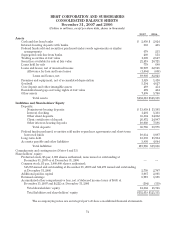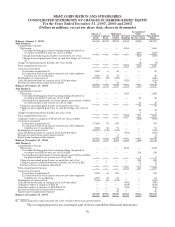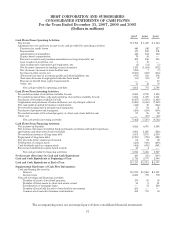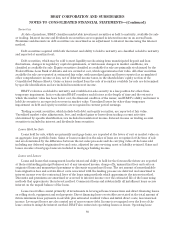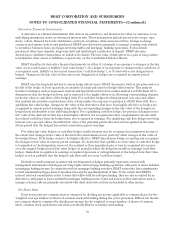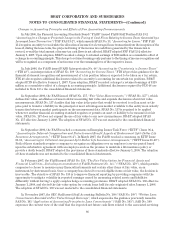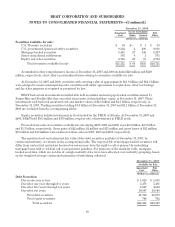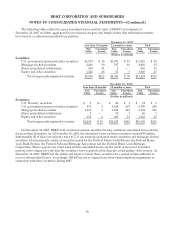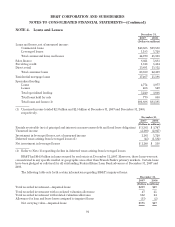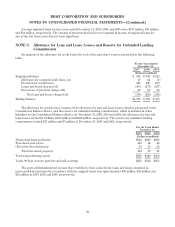BB&T 2007 Annual Report Download - page 84
Download and view the complete annual report
Please find page 84 of the 2007 BB&T annual report below. You can navigate through the pages in the report by either clicking on the pages listed below, or by using the keyword search tool below to find specific information within the annual report.BB&T CORPORATION AND SUBSIDIARIES
NOTES TO CONSOLIDATED FINANCIAL STATEMENTS—(Continued)
Goodwill and Other Intangible Assets
Goodwill represents the cost in excess of the fair value of net assets acquired (including identifiable
intangibles) in transactions accounted for as purchases. BB&T allocates goodwill to the business that receives
significant benefits from the acquisition. In accordance with provisions of SFAS No. 142, “Goodwill and Other
Intangible Assets”, goodwill is not amortized over an estimated useful life, but rather is tested at least annually
for impairment. BB&T performs its impairment testing in the fourth quarter of each year and more frequently if
circumstances exist that indicate a possible reduction in the fair value of the business below its carrying value.
BB&T measures impairment using the present value of estimated future cash flows. The analysis is based upon
available information regarding expected future cash flows and discount rates. Discount rates are based upon the
cost of capital specific to the industry in which the reporting unit operates. If the carrying value of the reporting
unit exceeds the fair value of the reporting unit, a second analysis is performed to measure the fair value of all
assets and liabilities. If, based on the second analysis, it is determined that the fair value of the assets and
liabilities of the reporting unit is less than the carrying value, BB&T would recognize impairment for the excess
of carrying value over fair value.
Core deposit and other intangible assets include premiums paid for acquisitions of core deposits (core deposit
intangibles) and other identifiable intangible assets. Intangible assets other than goodwill, which are determined
to have finite lives, are amortized based upon the estimated economic benefits received.
Loan Securitizations
BB&T securitizes most of its fixed-rate conforming mortgage loans, converts them into mortgage-backed
securities issued primarily through the Federal Home Loan Mortgage Corporation (“Freddie Mac”) and the
Federal National Mortgage Association (“Fannie Mae”), and sells the resulting securities to third party investors.
BB&T records loan securitizations as a sale when the transferred loans are legally isolated from its creditors and
the other accounting criteria for a sale are met. Gains or losses recorded on loan securitizations depend in part on
the net carrying amount of the loans sold, which is allocated between the loans sold and retained interests based
on their relative fair values at the date of sale. BB&T generally retains the mortgage servicing on loans sold.
Since quoted market prices are not typically available, BB&T estimates the fair value of these retained interests
using modeling techniques to determine the net present value of expected future cash flows. Such models
incorporate management’s best estimates of key variables, such as prepayment speeds and discount rates
appropriate for the risks involved. Gains and losses incurred on loans sold to third party investors are included in
mortgage banking income in the Consolidated Statements of Income.
BB&T also periodically securitizes mortgage loans that it intends to hold for the foreseeable future and
transfers the resulting securities to the securities available for sale portfolio. This is generally accomplished by
exchanging the loans for mortgage-backed securities issued primarily by Freddie Mac. Since the transfers are not
considered a sale, no gain or loss is recorded in conjunction with these transactions.
Mortgage Servicing Rights
BB&T has two classes of mortgage servicing rights for which it separately manages the economic risks:
residential and commercial. Beginning January 1, 2006, residential mortgage servicing rights are recorded on the
Consolidated Balance Sheets at fair value with changes in fair value recorded as a component of mortgage
banking income each period. In previous periods, residential mortgage servicing rights were recorded at the
lower of amortized cost or market. Commercial mortgage servicing rights are recorded as other assets on the
Consolidated Balance Sheets at lower of cost or market and amortized in proportion to, and over the estimated
period that, net servicing income is expected to be received based on projections of the amount and timing of
estimated future net cash flows. The amount and timing of estimated future net cash flows are updated based on
actual results and updated projections.
84


